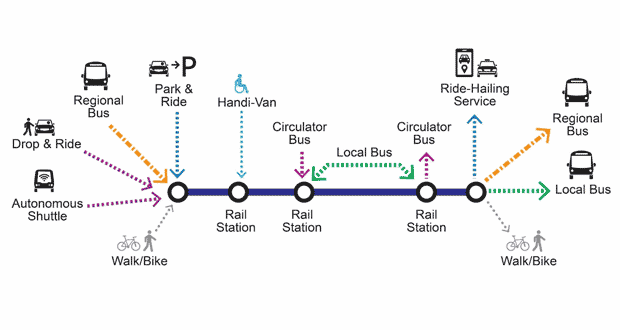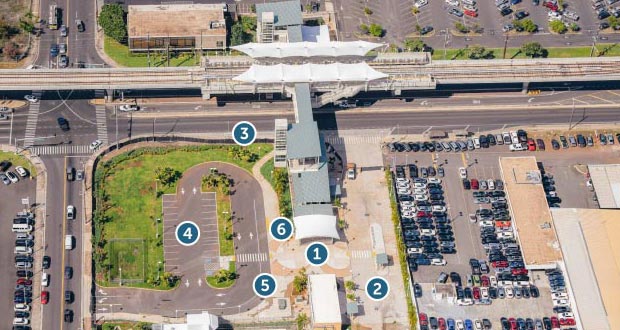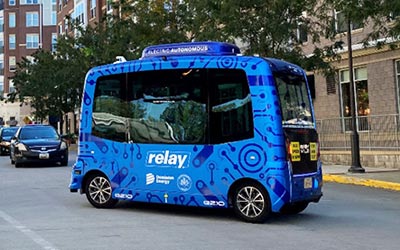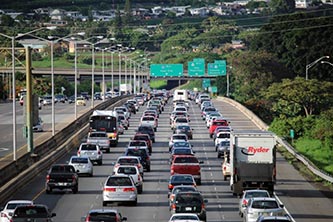Sustainability
Honolulu’s rail transit system transforms mobility on Oʻahu by creating the backbone of a sustainable, resilient transportation network that will shape the community for generations. Skyline’s high-capacity trains provide an efficient, reliable, and fast way to move large numbers of people across the island. Rail stations will anchor walkable, compact transit-oriented development (TOD) neighborhoods and help reduce dependence on automobiles.
Mobility Hubs

Rail stations will serve as mobility hubs that will link transportation providers, from buses and handi-vans to ride-hailing services like Uber/Lyft and shared micro-mobility. The rail system will provide a high-capacity backbone that will connect the communities. In the future, shared autonomous vehicles and other transportation systems can also connect at the stations.

The Hō‘ae‘ae Station (West Loch) is a good example of a mobility hub. At this station (1), seamless connections between bus and rail will occur at a new off-street bus transit center (2) as well as existing on-street bus stops (3) along Farrington Highway. The station also includes a small kiss-and-ride lot (4) with 20 spaces for drivers waiting to pick up arriving rail passengers, as well as curb space for handi-vans and other ride-hailing services (5). The station also features bicycle storage racks near the entrance (6), as well as special bicycle ramps along the stairways leading up to the rail boarding platforms.
Electrification

Rail will support the electrification of the transportation system and a transition to carbon-free mobility. As Hawaii switches to 100% renewable energy sources by 2045, our electrically-powered trains will provide carbon-free mobility across the island. Over time, some rail stations could also serve as charging hubs for electric buses and shared-autonomous vehicles.


More Efficient Land Use

Rail will support more efficient, compact transit-oriented development that can help keep the country, country. Compact, mixed-use commercial and residential buildings are concentrated within walking and biking distance around rail stations, and helps to reduce transportation costs and our dependence on the automobile. Ho‘opili is an example of a new transit-oriented community which is developing around the Keone‘ae and Honouliuli stations. Walkable, tree lined streets are connecting the rail station to new shops, services, and a variety of housing types to create a compact, vibrant community.
Over time, the stations can be integrated with commercial development, services, and new housing that will help to further reduce the reliance on the automobile. Vancouver is one of many cities around the world that have developed vibrant communities alongside their rail systems. Stations are connected to shopping malls and housing, allowing for very convenient mobility.
The Advantage of Rail
As a transportation system, rail is more efficient at moving people across the island than personal automobiles and has a much smaller footprint. Studies have found that roads, highways, and parking spaces account for about 14% of the available urban land in Hawaii – land which could otherwise be used for housing and other purposes.

HART and Sustainability
HART is committed to developing a sustainable and resilient rapid transit system that meets the mobility needs of present and future generations while fostering the environmental, economic and social well-being of residents and visitors on the island of Oahu.
LEED Certification for the Rail Operations Center
The U.S. Green Building Council (USGBC) has also certified that the Rail Operations Center (ROC) was designed and built to meet its Leadership in Energy and Environmental Design (LEED) Silver rating. The LEED system is an international standard for high-performance, sustainable buildings. To achieve this rating, the facility designers incorporated water efficient landscaping and fixtures, utilized low-emission materials and coolants, optimized energy performance, and incorporated other green building features.
APTA Sustainability Commitment

The American Public Transportation Association (APTA) has also recognized HART for its achievements with a Bronze-level recognition in the APTA Sustainability Commitment Program.
Project Status
The Overall Construction and Design Project Progress is based on the Estimate at Completion for the 2022 Recovery Plan scope to Ka‘ākaukukui (Civic Center) Station and the March 2031 Operational Readiness date.

